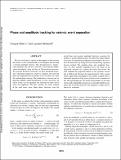Phase and amplitude tracking for seismic event separation
Author(s)
Demanet, Laurent; Li, Yunyue
DownloadLi-2015-Phase and amplitude.pdf (3.587Mb)
PUBLISHER_POLICY
Publisher Policy
Article is made available in accordance with the publisher's policy and may be subject to US copyright law. Please refer to the publisher's site for terms of use.
Terms of use
Metadata
Show full item recordAbstract
We have developed a method to decompose seismic records into atomic events, each defined by a smooth phase function and a smooth amplitude function. This decomposition is intrinsically nonlinear and calls for a nonconvex least-squares optimization formulation, along the lines of full-waveform inversion. To overcome the lack of convexity, we have developed an iterative refinement-expansion scheme to initialize and track the phase and amplitude for each atomic event. For short, we called the method phase tracking. The initialization is carried out by applying multiple signal classification to a few seed traces in which events can be separated and identified by their arrival times and amplitudes. We then construct the initial solution at the seed traces using linear phase functions from the arrival times and constant amplitude functions, assuming the medium is mostly dispersion free. We refine this initial solution to account for dispersion and imperfect knowledge of the wavelet at the seed traces by fitting the observed data using a gradient descent method. The resulting phase and amplitude functions are then carefully expanded across the traces in an adequately smooth way to match the whole data record. We have evaluated the proposed method on two synthetic records and a field record. Because the parametrization of the seismic events is physically meaningful, it also enables a simple form of bandwidth extension of the observed shot record to unobserved low and high frequencies. We tested this procedure on the same shot records. Bandwidth extension is in principle helpful to initialize full-waveform inversion with frequency sweeps and enhanced its resolution.
Date issued
2015-09Department
Massachusetts Institute of Technology. Department of MathematicsJournal
GEOPHYSICS
Publisher
Society of Exploration Geophysicists
Citation
Li, Yunyue Elita, and Laurent Demanet. “Phase and Amplitude Tracking for Seismic Event Separation.” GEOPHYSICS 80, no. 6 (November 2015): WD59–WD72. © 2015 Society of Exploration Geophysicists
Version: Final published version
ISSN
0016-8033
1942-2156